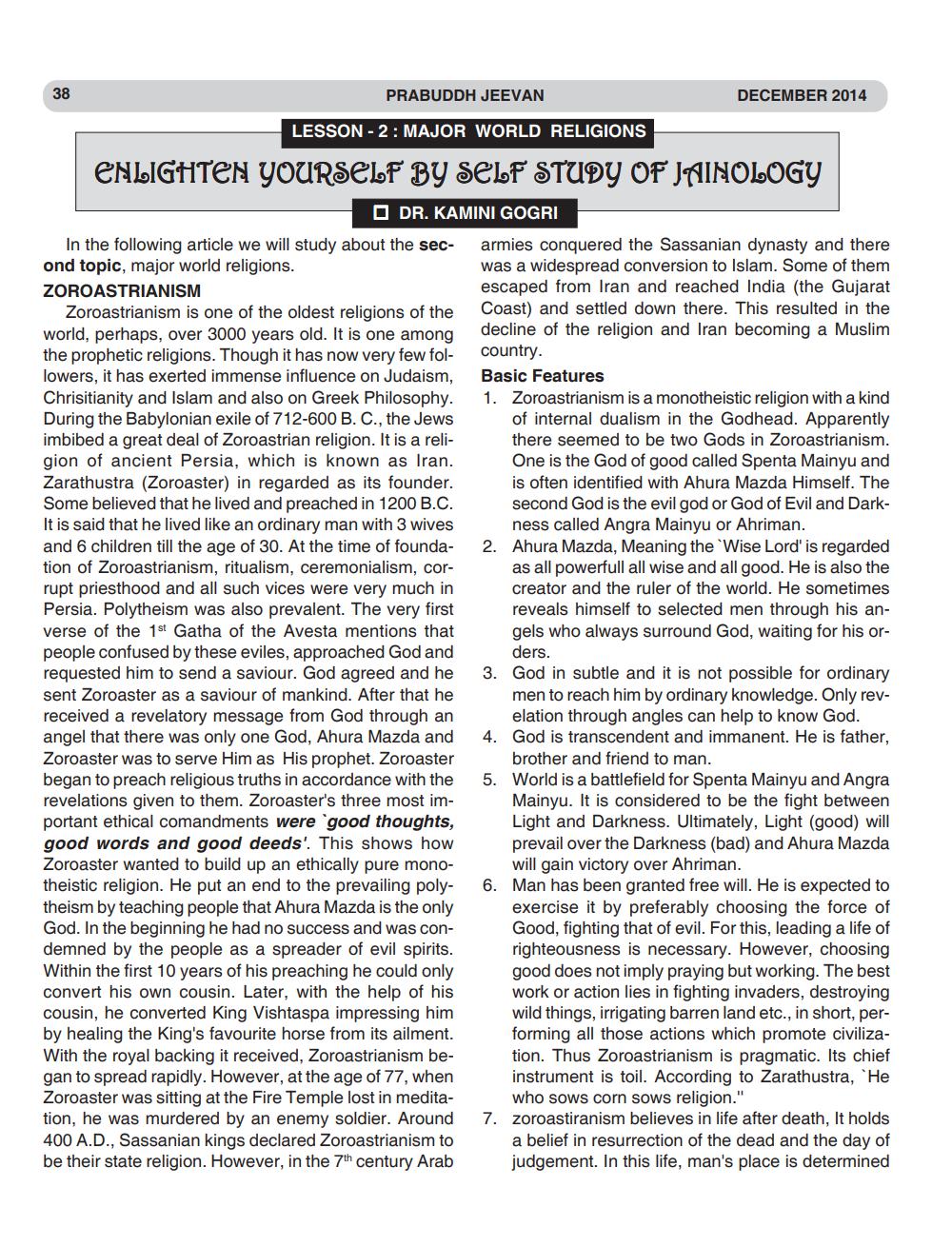________________
38
PRABUDDH JEEVAN
LESSON - 2: MAJOR WORLD RELIGIONS
ENLIGHTEN YOURSELF BY SELF STUDY OF JAINOLOGY
DR. KAMINI GOGRI
In the following article we will study about the second topic, major world religions.
DECEMBER 2014
ZOROASTRIANISM
Zoroastrianism is one of the oldest religions of the world, perhaps, over 3000 years old. It is one among the prophetic religions. Though it has now very few followers, it has exerted immense influence on Judaism, Chrisitianity and Islam and also on Greek Philosophy. During the Babylonian exile of 712-600 B. C., the Jews imbibed a great deal of Zoroastrian religion. It is a religion of ancient Persia, which is known as Iran. Zarathustra (Zoroaster) in regarded as its founder. Some believed that he lived and preached in 1200 B.C. It is said that he lived like an ordinary man with 3 wives and 6 children till the age of 30. At the time of foundation of Zoroastrianism, ritualism, ceremonialism, corrupt priesthood and all such vices were very much in Persia. Polytheism was also prevalent. The very first verse of the 1st Gatha of the Avesta mentions that people confused by these eviles, approached God and requested him to send a saviour. God agreed and he sent Zoroaster as a saviour of mankind. After that he received a revelatory message from God through an angel that there was only one God, Ahura Mazda and Zoroaster was to serve Him as His prophet. Zoroaster began to preach religious truths in accordance with the revelations given to them. Zoroaster's three most important ethical comandments were `good thoughts, good words and good deeds'. This shows how Zoroaster wanted to build up an ethically pure monotheistic religion. He put an end to the prevailing polytheism by teaching people that Ahura Mazda is the only God. In the beginning he had no success and was condemned by the people as a spreader of evil spirits. Within the first 10 years of his preaching he could only convert his own cousin. Later, with the help of his cousin, he converted King Vishtaspa impressing him by healing the King's favourite horse from its ailment. With the royal backing it received, Zoroastrianism began to spread rapidly. However, at the age of 77, when Zoroaster was sitting at the Fire Temple lost in meditation, he was murdered by an enemy soldier. Around 400 A.D., Sassanian kings declared Zoroastrianism to be their state religion. However, in the 7th century Arab
armies conquered the Sassanian dynasty and there was a widespread conversion to Islam. Some of them escaped from Iran and reached India (the Gujarat Coast) and settled down there. This resulted in the decline of the religion and Iran becoming a Muslim country.
Basic Features
1. Zoroastrianism is a monotheistic religion with a kind of internal dualism in the Godhead. Apparently there seemed to be two Gods in Zoroastrianism. One is the God of good called Spenta Mainyu and is often identified with Ahura Mazda Himself. The second God is the evil god or God of Evil and Darkness called Angra Mainyu or Ahriman.
2. Ahura Mazda, Meaning the `Wise Lord' is regarded
as all powerfull all wise and all good. He is also the creator and the ruler of the world. He sometimes reveals himself to selected men through his angels who always surround God, waiting for his orders.
3. God in subtle and it is not possible for ordinary
men to reach him by ordinary knowledge. Only revelation through angles can help to know God. 4. God is transcendent and immanent. He is father, brother and friend to man.
5. World is a battlefield for Spenta Mainyu and Angra Mainyu. It is considered to be the fight between Light and Darkness. Ultimately, Light (good) will prevail over the Darkness (bad) and Ahura Mazda will gain victory over Ahriman.
6. Man has been granted free will. He is expected to
exercise it by preferably choosing the force of Good, fighting that of evil. For this, leading a life of righteousness is necessary. However, choosing good does not imply praying but working. The best work or action lies in fighting invaders, destroying wild things, irrigating barren land etc., in short, performing all those actions which promote civilization. Thus Zoroastrianism is pragmatic. Its chief instrument is toil. According to Zarathustra, `He who sows corn sows religion."
7. zoroastiranism believes in life after death, It holds
a belief in resurrection of the dead and the day of judgement. In this life, man's place is determined




